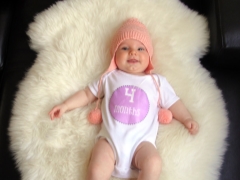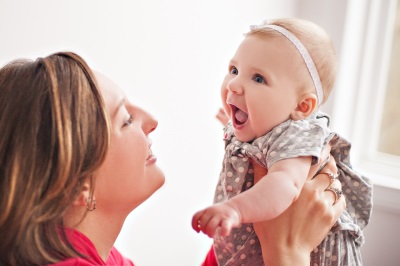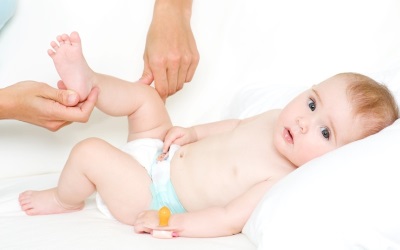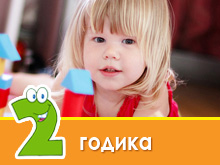Child development at 4 months
Four-month baby becomes more attentive, active and cheerful. He changes physically and emotionally, delighting parents with new skills and achievements. What did the baby learn by the age of 4 months and how can one help the development of the toddler of this age?
Physiological changes
- A 4-month-old baby significantly strengthens the back muscles and improves their coordination, with the result that the child learns to roll over. However, the baby cannot sit still, therefore it is not recommended to seat it with support in the form of pillows.
- Many reflexes characteristic of the newborn have already disappeared or have begun to fade, for example, the crawling and Moro reflexes. The hypertonus of the arms is already completely gone, and in the legs is still preserved.
- The lacrimal glands of the child begin their work, therefore, when crying, the baby already has tears.
- The baby’s vision begins to perceive more and more colors. Crumbs like clean tones of yellow, red, blue and green. If the child has had a squint after birth due to weakness of the eye muscles, by 4 months it should pass, as the eye muscles become stronger.
- The hearing of the child is also actively developing. Hearing the sounds, the crumb turns in their direction. The kid already knows how to distinguish the voices of loved ones from the voices of strangers. Hearing the music, the little hornet begins to shake his head to the beat. The little ones like rhythmic melodies with low tones more than high tones.
- The work of the baby's digestive system has already improved and become more stable, most children have cramped colic.
- In some babies, the formation of saliva increases, but this is not connected with the appearance of the first teeth, but with the constant finding of hands and various objects in the baby’s mouth, which he studies in this way.
- Baby's hair and nails grow 4 months very quickly.
In emotional terms, the crumb of this age becomes more developed and badly needs to communicate with adults. Among all people, the baby especially distinguishes mother and reacts to her mood. If mommy is sad, the baby will feel it, and her mother's smile will certainly respond with her own charming smile.
Physical development
Since the motor activity of a 4-month-old baby is still low, the weight gain at this age is quite large and amounts to about 750 grams. The growth of the crumbs becomes 2.5 cm longer, and the circumference of the head and the thorax at this age becomes the same (by the fifth month the thorax becomes more than the girth of the head).
Although all children develop in different ways, the average indicators for most infants of this age and the limits of norms help to reveal whether the infant is growing normally and whether the pediatrician should not pay attention to exceeding or decreasing any of the parameters of physical development. We presented the norms for 4-month-old babies in the table:
Indicator | 4 month average | Boys in 4-5 months | Girls 4-5 months |
Weight | 6400-7000 g | 5600-8700 g | 5000-8200 g |
Growth | 62.1-63.9 cm | 59.7-68 cm | 57.8-66.4 cm |
Head circumference | 40.6-41.6 cm | 39.2-44 cm | 38.1-43.1 cm |
Chest circumference | 41-41.6 cm | 38.6-44.6 cm | 38.9-43 cm |
What baby can?
- Lying on his stomach, the crumb confidently holds his head and examines everything around.Moreover, the baby can already lift the entire upper part of the body together with the head and rest on the palms.
- By four months, the baby has mastered coups on the tummy from a position on the back. Some kids even learned to roll back and try to crawl on his stomach, helping himself with his legs.
- Lying on his back, the baby has learned to raise his head with the shoulder girdle. This is the first attempt of the baby to sit down.
- The little one is already managing well with her own hands. During the feeding time, the hands of the child often hug the mother’s breasts or clasp the bottle. Staying in the crib, the crumb already confidently grasps with hands the objects that hang over it (mobile toys).
- During games, the child smiles and often laughs. A child at the age of 4 months is very emotional, he can either rejoice or be upset or offended.
- Walking a four-month-old baby is quite long. You will hear the sounds of "a", "o", "b", "p" and "m" from the baby. Some babies even learned to tie them in syllables.
Note that each baby develops at its own pace and some skills at the toddler may appear earlier, and others - a little later than their peers. However, there are skills, the lack of which at 4 months of age should alert the parents. Consult your pediatrician if the baby:
- Not enough items and does not hold them in the handle for a while.
- It does not rise from the support on the hands when lying on his stomach.
- Not learned to roll over on his stomach.
- In the upright position (when the parent supports under the arms) does not rest with the feet on the surface.
- When they pull up with both handles, the head of the child tilts back.
- Does not show any emotions and does not react to communication with people.
On whether to worry if there are deviations from the norm, see the video of Dr. Komarovsky.
The fact that, according to the rules, a child should be able to be 4 months old, see the next video of Larisa Sviridova.
Classes for development
- Hang bright toys over your child so that the crumb can grab them with handles. Well, if such toys will have a different texture or make sounds.
- Put rattles of various sizes and different shapes into the baby’s handles. Offer the crumbs to touch not only the rattles, but also a soft toy, a small doll, a musical toy with buttons, a rubber beeper and other objects.
- Play hide and seek with the baby. Hide your face behind a handkerchief, then open your face and say “cuckoo”. You can also close your eyes with your own hands, and then close the eyes of your baby with your hands. Crumbs will certainly like all the variants of the game.
- Play with the baby in the "magpie-crow". Since there are centers on the palm that stimulate the work of the intestines, this game will be useful not only for the muscles of the hand, but also for digestion.
- Blow bubbles and let the crumb watch their slow flight.
- Put one bright-colored sock on one baby's foot so that the little tot will want to grab it. You can also tie a bell to the baby's foot. Be sure to praise the crumb when the child gets a sock or bell.
- For better physical development and coordination training, hold the baby by the handles, lift them up, and then lower them along the body. After that, cross your arms over your chest and spread them apart.
- During gymnastics, massage and any other things with your child, drink songs and pronounce nursery rhymes, and while putting the baby to bed, sing a lullaby or tell a fairy tale.
- Build “dialogues” with baby to make the baby learn to imitate your speech. Speak different words so that the baby can see your facial expressions. It is also important to repeat the sounds that the child utters after the baby.
Try to spend with the child the lesson "Worm", which is shown by Tatyana Lazareva in the next video.
Care
The morning of a four-month-old baby, as before, begins with hygienic procedures.Wash the baby's face and wipe the eyes, clean the ears and nose when necessary. Cutting nails at this age is quite often, as they grow quickly, and the baby constantly puts handles in the mouth.
Walk with a 4-month toddler should be twice a day, focusing on weather conditions. In summer, the duration of walks can be up to 6 hours. In winter, it is advised to go for a walk for 1-2 hours. Refrain from it should be only in severe frost, rain or gusty wind.
Gymnastics and light massages are recommended for children twice a day. First, lay the baby on the back, take the handles and make them in a circular motion. Then turn the baby on one side and on the other, then take the legs of the toddler and move them. Next, the crumbs need to turn on his stomach, and in this position bend and straighten his legs.
In the process of massage it is worth using pads.
The massage technique at 4 months is shown in detail by Nikolay Nikonov - the leading doctor and massage therapist in Russia in the next video.
To improve sleep, you should create a certain ritual that will set up the infant for a night's sleep. This ritual may include bathing, stroking the baby’s body, feeding, lullaby or a fairy tale. Repeat this ritual daily, without missing its elements.
Remember the safety rules and do not leave a crumb to one, because many babies at 4 months have already learned to roll over, and those who have not yet succeeded can please with a new skill at any time.
The fact that the first thing you need to baby in 4 months, see the video of Larisa Sviridova.
Daily regime
The child may already be awake for more than 2 hours in a row and behaves very actively during these periods.
A four-month baby sleeps per day up to 15 hours. Night sleep at this age lasts about 10 hours. Daytime dreams for many children of 4 months becomes three, and their total duration is about 5 hours. The optimum time of laying on a night's sleep is called 19-21 hours. If you start laying up later, there may be difficulties due to overworking the baby.
Baby breastfeeding continues to receive exclusively breast milk. At the same time the crumb began to be applied to the breast less often. This usually happens in the process of falling asleep, during sleep, and also immediately after waking up. As a result, the child already has a fairly accurate mode of feeding.
The baby is bottle-fed diet more stringent. It provides for a certain amount of the mixture and 6 feedings per day at intervals of about 3.5 hours. The amount of the mixture, which is needed by the tiny Artificial One per day, is determined by dividing the baby’s weight by 7. This total amount is divided equally into 6 feedings.
On average, 4 months old babies eat 900-1000 ml of the adapted mixture per day. For one feeding, the baby receives an average of 150-170 ml of the mixture. Also at this age babies receiving the mixture begin to feed. The first dish of lure choose vegetables or porridge. A new product is given in the second feeding, increasing its quantity to 100 g.
Do not forget to diversify the day crumbs with different pies. One of them is presented by Tatyana Lazareva in the next video.
Typical day
Communicating with a 4-month-old baby becomes more interesting day by day. The daily routine of each toddler is individual and depends on various factors, but in order to understand what to focus on, we will tell you how an ordinary day with a child of this age can look like:
6: 30 | Awakening for the first feeding, hygienic procedures. |
8: 00 | The first day of sleep. |
10: 00 | Awakening for the second feeding, wakefulness period. |
11: 30 | Walk and second afternoon nap in the fresh air. |
13: 30 | Returning home, awakening for the third feeding. |
14: 00 | Waking period, educational games. |
15: 30 | Walk and third nap in the open air. |
17: 00 | Returning home, awakening for the fourth feeding. |
17: 30 | Period of wakefulness. |
19: 30 | Bathing, fifth feeding, laying down at night. |
00: 00 | Awakening for the sixth feeding and immediately falling asleep. |
The development of the baby will also be helped by the exercises shown in the next video, according to the method of O. N. Teplyakova, an expert in intellectual development.
Frequent problems
- Biting her mother's breast while nursing. With this action, the baby begins its separation from the mother and checks her reaction. If at this moment the mother screams, the child will understand that he is not an inseparable part of the mother.
- Frequent distractions during feedings. Four-month-old children often check their mother and distract or turn away from her breast during the feeding process. To take the breast in such cases is not necessary. The correct behavior of the mother will be calm waiting until the crumb returns to feeding.






































